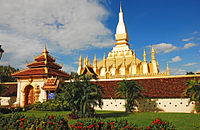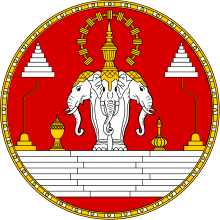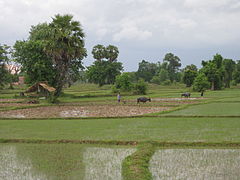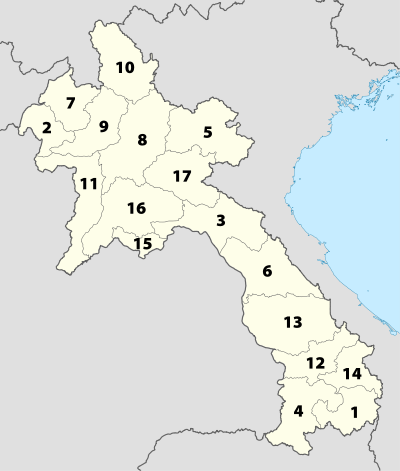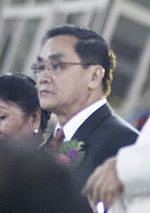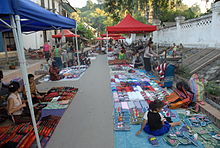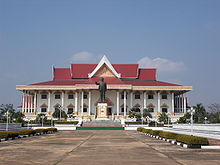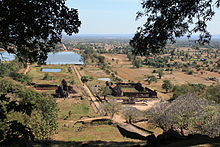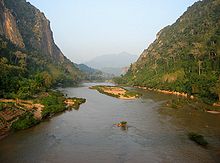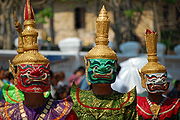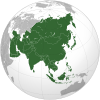- Laos
-
This article is about the country. For other uses, see Laos (disambiguation).
Lao People's Democratic Republic Sathalanalat Paxathipatai
Paxaxon Lao

Flag Emblem Motto: "ສັນຕິພາບ ເອກະລາດ ປະຊາທິປະໄຕ ເອກະພາບ ວັດທະນາຖາວອນ"
"Peace, independence, democracy, unity and prosperity"Anthem: Pheng Xat Lao
"Hymn of the Lao People"Location of Laos (green)in ASEAN (dark grey) — [Legend]
Capital
(and largest city)Vientiane
17°58′N 102°36′E / 17.967°N 102.6°EOfficial language(s) Lao Official scripts Lao script Demonym Laotian, Lao Government Unitary communist and single-party state - President Choummaly Sayasone - Prime Minister Thongsing Thammavong - President of Lao National Assembly Pany Yathotu - President of LFNC Sisavath Keobounphanh - LPRP General Secretary Choummaly Sayasone Independence From France - Autonomy 19 July 1949 - Declared 9 Nov 1953 Area - Total 236,800 km2 (83rd)
91,428.991 sq mi- Water (%) 2 Population - 2009 estimate 6,800,000 [1] (104th) - 1995 census 4,574,848 - Density 26.7/km2 (177th)
69.2/sq miGDP (PPP) 2010 estimate - Total $15.693 billion[2] (130th) - Per capita $2,435[2] (48th) GDP (nominal) 2010 estimate - Total $6.341 billion[2] (137th) - Per capita $984[2] (147th) Gini (2008) 34.6 (medium) HDI (2010)  0.497[3] (medium) (122nd)
0.497[3] (medium) (122nd)Currency Kip ( LAK)Time zone (UTC+7) Drives on the right Internet TLD .la Calling code 856 Laos (
 i/ˈlaʊs/, /ˈlɑː.oʊs/, or /ˈleɪ.ɒs/)[4][5][6] Lao: ສາທາລະນະລັດ ປະຊາທິປະໄຕ ປະຊາຊົນລາວ Sathalanalat Paxathipatai Paxaxon Lao, officially the Lao People's Democratic Republic, is a landlocked country in Southeast Asia, bordered by Burma and China to the northwest, Vietnam to the east, Cambodia to the south and Thailand to the west. Its population was estimated to be 6.8 million in 2009.[1]
i/ˈlaʊs/, /ˈlɑː.oʊs/, or /ˈleɪ.ɒs/)[4][5][6] Lao: ສາທາລະນະລັດ ປະຊາທິປະໄຕ ປະຊາຊົນລາວ Sathalanalat Paxathipatai Paxaxon Lao, officially the Lao People's Democratic Republic, is a landlocked country in Southeast Asia, bordered by Burma and China to the northwest, Vietnam to the east, Cambodia to the south and Thailand to the west. Its population was estimated to be 6.8 million in 2009.[1]Laos traces its history to the Kingdom which existed from the 14th to the 18th century when it split into three separate kingdoms. In 1893, it became a French protectorate, with the three kingdoms, Kingdom of Luang Phrabang, Kingdom of Vientiane and Kingdom of Champasak, uniting to form what is now known as Laos. It briefly gained independence in 1945 after Japanese occupation, but returned to French rule until it was granted autonomy in 1949. Laos became independent in 1954, with a constitutional monarchy under Sisavang Vong. Shortly after independence, a long civil war ended the monarchy, when the Communist Pathet Lao movement came to power in 1975.
Laos is a single-party socialist republic. The capital city is Vientiane. Other large cities include Luang Prabang, Savannakhet and Pakse. The official language is Lao. Most people are Lao with a significant proportion of indigenous religion as well. It is a rising power in providing electricity to neighboring countries such as Thailand, China and Vietnam and the economy is accelerating rapidly with the demands for its metals.[7][7] It is a member of the Asia Pacific Trade Agreement (APTA), Association of Southeast Asian Nations (ASEAN), East Asia Summit and La Francophonie. Laos applied for membership of the World Trade Organization (WTO) in 1997.
Contents
Etymology
In the Lao language, the country's name is "Muang Lao" (ເມືອງລາວ) or "Pathet Lao", both of which literally mean "Lao Country".[8] The French, who united the three separate Lao kingdoms in French Indochina in 1893, named the country as the plural of the ethnic group (in French, the final "s" at the end of a word is usually silent, thus it would be also be pronounced "Lao").[9]
History
Main article: History of LaosLan Xang 1353–1893
Main article: Lan XangLaos traces its history to the kingdom of Lan Xang (Million Elephants), founded in the 14th century, by a Lao warlord, Fa Ngum, who took over Vientiane with 10,000 Khmer troops. Ngum had been a descendent from a long line of Lao kings, tracking back to Khoun Boulom. He made Theravada Buddhism the state religion and Lan-Xang prospered. Within 20 years of its formation, the kingdom expanded eastward to Champa and along the Annamite mountains in Vietnam. His ministers, unable to tolerate his ruthlessness, forced him into exile to present day Thai province of Nan in 1373,[10] where he later died. Fa Ngum's eldest son, Oun Heuan, (took the title Samsenthai) came to the throne and reigned for 43 years. During his reign, Lan Xang became an important trade centre. After his death in 1421, Lan Xang collapsed into warring factions for the next 100 years.
In 1520, Photisarath came to the throne and moved the capital from Luang Phrabang to Vientiane to avoid Burmese invasion. Setthathirat became king in 1548, after his father was killed, and ordered the construction that would become the symbol of Laos, That Luang. Setthathirat disappeared in the mountains on his way back from a military expedition into Cambodia and Lan Xang began to rapidly decline. It was not until 1637, when Sourigna Vongsa ascended the throne that Lan Xang would further expand its frontiers. His reign is often regarded as Laos's golden age. When he died, leaving Lan Xang without an heir, the kingdom divided into three principalities. Between 1763 and 1769, Burmese armies overran northern Laos and annexed Luang Phrabang, while Champasak eventually came under Siamese suzerainty.
Chao Anouvong was installed as a vassal king of Vientiane by the Siamese. He encouraged a renaissance of Lao fine arts and literature and improved relations with Luang Phrabang. Although he was pressured to pay tribute to the Vietnamese, he rebelled against the Siamese. The rebellion failed and Vientiane was ransacked.[11] Anouvong was taken to Bangkok as a prisoner, where he later died.
French rule 1893–1954
In the late 19th century, Luang Prabang was ransacked by the Chinese Black Flag Army.[12] France rescued King Oun Kham and added Luang Phrabang to the 'Protectorate' of French Indochina. Shortly after, the Kingdom of Champasak and the territory of Vientiane were also added to the protectorate. King Sisavang Vong of Luang Phrabang, became ruler of a unified Laos and Vientiane once again became the capital. Laos was never important to France,[13] except as a buffer state between British-influenced Thailand and the more economically important Annam and Tonkin. During their rule, the French introduced the corvee, a system that forced every male Lao to contribute 10 days of manual labour per year to the colonial government. Laos produced tin, rubber and coffee, but never accounted for more than 1% of French Indochina's exports. By 1940, only 600 French citizens lived in Laos.[14]
Following a brief Japanese occupation during World War II, the country declared its independence in 1945, but the French under Charles de Gaulle re-asserted control. In 1950 Laos was granted semi-autonomy as an "associated state" within the French Union. France remained in de facto control until 1954, when Laos gained full independence as a constitutional monarchy.
Kingdom of Laos and war 1954–75
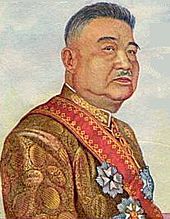 King Sisavang Vong of Laos
King Sisavang Vong of Laos Main articles: Kingdom of Laos and Laotian Civil War
Main articles: Kingdom of Laos and Laotian Civil WarUnder a special exemption to the Geneva Convention, a French military training mission continued to support the Royal Lao Army. In 1955, the U.S. Department of Defense created a special Programs Evaluation Office to replace French support of the Royal Lao Army against the communist Pathet Lao as part of the U.S. containment policy.
Laos was dragged into the Vietnam War. The eastern parts of the country followed North Vietnam and adopted North Vietnam as a fraternal country. Laos allowed North Vietnam to use its land as a supply route for its war against the South. In response, the United States initiated a bombing campaign against the North Vietnamese, supported regular and irregular anticommunist forces in Laos and supported a South Vietnamese invasion of Laos. The result of these actions were a series of coups d'état and, ultimately, the Laotian Civil War between the Royal Laotian government and the Pathet Lao.
In the Civil War, the heavily-armed and battle-hardened North Vietnamese Army was the real power behind the Pathet Lao insurgency. In 1968, the North Vietnamese Army launched a multi-division attack to help the Pathet Lao to fight the Royal Lao Army. The attack resulted in the army largely demobilizing, leaving the conflict to irregular forces raised by the United States and Thailand. The attack resulted in many lost lives.[citation needed]
Massive aerial bombardment was carried out by the United States. The Guardian reported that Laos was hit by an average of one B-52 bombload every eight minutes, 24 hours a day, between 1964 and 1973. US bombers dropped more ordnance on Laos in this period than was dropped during the whole of the Second World War. Of the 260 million bombs that rained down, particularly on Xiangkhouang Province on the Plain of Jars, some 80 million failed to explode, leaving a deadly legacy.[15]Laos is the most heavily-bombed country, per capita, in the world. Because it was particularly heavily affected by cluster bombs during this war, Laos was a strong advocate of the Convention on Cluster Munitions to ban the weapons and assist victims, and hosted the First Meeting of States Parties to the convention in November 2010.
In 1975, the Pathet Lao, along with Vietnam People's Army and backed by the Soviet Union, overthrew the royalist Lao government, forcing King Savang Vatthana to abdicate on 2 December 1975. He later died in captivity.
Lao People's Democratic Republic (1975–present)
On 2 December 1975, after taking control of the country, the Pathet Lao government under Kaysone Phomvihane renamed the country as the Lao People's Democratic Republic and signed agreements giving Vietnam the right to station armed forces and to appoint advisers to assist in overseeing the country. Laos was requested in 1979 by the Socialist Republic of Vietnam to end relations with the People's Republic of China, leading to isolation in trade by China, the United States, and other countries.
Geography
Main article: Geography of Laos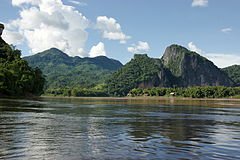 Mekong River flowing through Luang Prabang
Mekong River flowing through Luang Prabang
Laos is a landlocked country in Southeast Asia, lying mostly between latitudes 14° and 23°N (a small area is south of 14°), and longitudes 100° and 108°E. Its thickly forested landscape consists mostly of rugged mountains, the highest of which is Phou Bia at 2,818 metres (9,245 ft), with some plains and plateaus. The Mekong River forms a large part of the western boundary with Thailand, whereas the mountains of the Annamite Chain form most of the eastern border with Vietnam. The climate is tropical and monsoon.[16]
There is a distinct rainy season from May to November, followed by a dry season from December to April. Local tradition holds that there are three seasons (rainy, cold and hot) as the latter two months of the climatologically defined dry season are noticeably hotter than the earlier four months. The capital and largest city of Laos is Vientiane and other major cities include Luang Prabang, Savannakhet and Pakse.
In 1993, the Laos government set aside 21% of the nation's land area for habitat conservation preservation.[17] The country is one of four in the opium poppy growing region known as the "Golden Triangle". According to the October 2007 UNODC fact book "Opium Poppy Cultivation in South East Asia," the poppy cultivation area was 15 square kilometres (5.8 sq mi), down from 18 square kilometres (6.9 sq mi) in 2006.
Laos can be considered to consist of three geographical areas: north, central, and south. [18]
Administrative divisions
Main articles: Provinces of Laos and Districts of LaosLaos is divided into 16 provinces (qwang) and one prefecture (Nakhonluang ViengChan) which includes Vientiane Capital (Na Kone Luang Vientiane). Provinces are further divided into districts (muang) and then villages (baan). An 'urban' village is essentially a town. [19]
Number State Capital Area (km²) Population 1 Attapeu Attapeu 10,320 114,300 2 Bokeo Ban Houayxay 6,196 149,700 3 Bolikhamsai Paksan 14,863 214,900 4 Champasak Pakse 15,415 575,600 5 Hua Phan Xam Neua 16,500 322,200 6 Khammouane Thakhek 16,315 358,800 7 Luang Namtha Luang Namtha 9,325 150,100 8 Luang Phrabang Luang Phrabang 16,875 408,800 9 Oudomxay Muang Xay 15,370 275,300 10 Phongsali Phongsali 16,270 199,900 11 Sayabouly Sayabouly 16,389 382,200 12 Salavan Salavan 10,691 336,600 13 Savannakhet Savannakhet 21,774 721,500 14 Sekong Sekong 7,665 83,600 15 Vientiane Vientiane 3,920 726,000 16 Vientiane Muang Phon-Hong 15,927 373,700 17 Xieng Khouang Phonsavan 15,880 37,507 Government and politics
Main articles: Politics of Laos and Foreign relations of LaosLaos is a communist single-party socialist republic. The only legal political party is the Lao People's Revolutionary Party (LPRP). The head of state is President Choummaly Sayasone, who is also the General Secretary of the Lao People's Revolutionary Party. The head of government is Prime Minister Thongsing Thammavong. Government policies are determined by the party through the all-powerful eleven-member Political Bureau and the 61-member Central Committee. Important government decisions are vetted by the Council of Ministers.
Laos' first, French-written and monarchical constitution was promulgated on 11 May 1947 and declared Laos to be an independent state within the French Union. The revised constitution of 11 May 1957 omitted reference to the French Union, though close educational, health and technical ties with the former colonial power persisted. The 1957 document was abrogated on 3 December 1975, when a communist People's Republic was proclaimed. A new constitution was adopted in 1991 and enshrined a "leading role" for the LPRP. In 1990, deputy minister for science & technology Thongsouk Saysangkhi resigned from the government and party, calling for political reform. He died in captivity in 1998.[20]
In 1992, elections were held for a new 85-seat National Assembly with members elected by secret ballot to five-year terms. This National Assembly, which essentially acts as a rubber stamp for the LPRP, approves all new laws, although the executive branch retains authority to issue binding decrees. The most recent elections took place in April 2011. The assembly was expanded to 99 members in 1997, to 115 members in 2006 and finally to 132 members during the 2011 elections.
Hmong conflict
The government of Laos has been accused of committing genocide against that country’s Hmong ethnic minority.[21]
Some Hmong groups fought as CIA-backed units on the Royalist side in the Laos civil war. After the Pathet Lao took over the country in 1975, the conflict continued in isolated pockets. In 1977 a communist newspaper promised the party would hunt down the “American collaborators” and their families “to the last root”.
As many as 200,000 Hmong went into exile in Thailand, with many ending up in the USA. A number of Hmong fighters hid out in mountains in Xiangkhouang Province for many years, with a remnant emerging from the jungle in 2003.[22]
Human rights
Main article: Human rights in LaosThe Constitution that was promulgated in 1991 and amended in 2003 contains most key safeguards for human rights. For example, in Article 8 it makes it clear that Laos is a multiethnic state and is committed to equality between ethnic groups. The Constitution also has provisions for gender equality and freedom of religion, for freedom of speech, press and assembly. On 25 September 2009, Laos ratified the International Covenant on Civil and Political Rights, nine years after signing the treaty. The policy objectives of both the Lao government and international donors remain focused toward achieving sustainable economic growth and poverty reduction.[23][24]
However, Amnesty International has raised concerns about the ratification record of the Laos Government on human rights standards and its lack of cooperation with the UN human rights mechanisms and legislative measures which impact negatively on human rights. It has also raised concerns in relation to freedom of expression, poor prison conditions, restrictions on freedom of religions, protection of refugees and asylum-seekers and the death penalty.[25]
In October 1999, 30 young people were arrested for attempting to display posters calling for peaceful economic, political and social change in Laos. Five of them were arrested and subsequently sentenced to up to 10 years imprisonment on charges of treason. One has since died due to his treatment by prison guards, while one has been released. The surviving three men should have been released by October 2009, but their whereabouts remains unknown.[25]
Laos and Vietnamese troops were reported to have raped and killed four Christian Hmong women in Xieng Khouang province in 2011, according to US campaign group The Centre for Public Policy Analysis. CPPA also said other Christian and independent Buddhist and animist believers were being persecuted.[26][27]
Economy
Main article: Economy of LaosNight Market in Luang Prabang
The Lao economy depends heavily on investment and trade with its neighbours, Thailand, Vietnam, and, especially in the north, China. Pakxe has also experienced growth based on cross-border trade with Thailand and Vietnam. In 2011, the Lao Securities Exchange began trading.
Subsistence agriculture still accounts for half of the GDP and provides 80 percent of employment. Only 4.01 percent of the country is arable land, and 0.34 percent used as permanent crop land,[28] the lowest percentage in the Greater Mekong Subregion.[29] Rice dominates agriculture, with about 80 percent of the arable land area used for growing rice.[30] Approximately 77 percent of Lao farm households are self-sufficient in rice.[31]
Through the development, release and widespread adoption of improved rice varieties, and through economic reforms, production has increased by an annual rate of 5 percent between 1990 and 2005,[32] and Lao PDR achieved a net balance of rice imports and exports for the first time in 1999.[33] Lao PDR may have the greatest number of rice varieties in the Greater Mekong Subregion. Since 1995 the Lao government has been working with the International Rice Research Institute to collect seed samples of each of the thousands of rice varieties found in Laos.[34]
The economy receives development aid from the IMF, ADB and other international sources, and foreign direct investment for development of the society, industry, hydropower and mining, most notably copper and gold. Tourism is the fastest-growing industry in the country. Economic development in Laos has been hampered by brain drain, with a skilled emigration rate of 37.4 percent in 2000.[35]
Laos is rich in mineral resources but imports petroleum and gas. Metallurgy is an important industry, and the government hopes to attract foreign investment to develop the substantial deposits of coal, gold, bauxite, tin, copper and other valuable metals. In addition, the country's plentiful water resources and mountainous terrain enable it to produce and export large quantities of hydroelectric energy. Of the potential capacity of approximately 18,000 megawatts, around 8,000 megawatts have been committed for exporting to Thailand and Vietnam.[36]
The country's most widely recognised product may well be Beerlao which is exported to a number of countries including neighbours Cambodia and Vietnam. It is produced by the Lao Brewery Company.
Tourism
Main article: Tourism in LaosThe tourism sector has grown rapidly, from 80,000 international visitors in 1990, to 1.876 million in 2010.[37] Tourism is expected to contribute US$679.1 million to gross national product in 2010, rising to US$1,585.7 million by 2020. In 2010, one in every 10.9 jobs was in the tourism sector. Export earnings from international visitors and tourism goods are expected to generate 15.5% of total exports or US$270.3 million in 2010, growing in nominal terms to US$484.2 million (12.5% of total) in 2020.[38]
 Hmong girls on the Plain of Jars
Hmong girls on the Plain of Jars
Laos has become popular with tourists for its relaxed style of living and for retaining elements of the "original Asia" lost elsewhere. The official tourism slogan is "Simply Beautiful". The main attractions for tourists include Buddhist culture and colonial architecture in Luang Prabang; gastronomy and ancient temples in the capital of Vientiane; backpacking in Muang Ngoi Neua and Vang Vieng; ancient and modern culture and history in The Plain of Jars region (main article: Phonsavan); trekking and visiting hill tribes in a number of areas including Phongsaly and Luang Namtha; wildlife spotting in Nam Et-Phou Louey; caves and waterfalls near Thakhek; relaxation, the Irrawaddy dolphin and Khone Phapheng Falls at Si Phan Don or as they are known in English, the Four Thousand Islands; Wat Phu, an ancient Khmer temple complex; and the Bolaven Plateau for waterfalls and coffee.
Luang Prabang and Wat Phu are both UNESCO World Heritage sites, with the Plain of Jars expected to join them once more work to clear UXO has been completed. Major festivals include Laos New Year which is celebrated around 13–15 April and involves a water festival similar but more subdued than that of Thailand and other South-East Asian countries.
The Lao National Tourism Administration, related government agencies and the private sector are working together to realise the vision put forth in the country's National Ecotourism Strategy and Action Plan. This includes decreasing the environmental and cultural impact of tourism; increasing awareness in the importance of ethnic groups and biological diversity; providing a source of income to conserve, sustain and manage the Lao protected area network and cultural heritage sites; and emphasising the need for tourism zoning and management plans for sites that will be developed as ecotourism destinations.[39]
Laos is known for its silk and local handicraft product, both of which are on display in Luang Prabang's night market, among other places. Another speciality is mulberry tea.
Environmental problems
Laos is increasingly suffering from environmental problems, with deforestation a particular issue[40] as expanding commercial exploitation of the forests, plans for additional hydroelectric facilities, foreign demand for wild animals and nonwood forest products for food and traditional medicines, and a growing population put increasing pressure on the forests.
The United Nations Development Programme warns that: "Protecting the environment and sustainable use of natural resources in Lao PDR is vital for poverty reduction and economic growth."[41]
In April 2011, The Independent newspaper reported that Laos had started work on the controversial Xayaburi Dam on the Mekong River without getting formal approval. Environmentalists say the dam will adversely affect 60 million people and Cambodia and Vietnam—concerned about the flow of water further downstream—are officially opposed to the project. The Mekong River Commission, a regional intergovernmental body designed to promote the "sustainable management" of the river, famed for its giant catfish, carried out a study that warned if Xayaburi and subsequent schemes went ahead, it would "fundamentally undermine the abundance, productivity and diversity of the Mekong fish resources".[42] Neighbouring Vietnam warned that the dam would harm the Mekong Delta, which is the home to nearly 20 million people and supplies around 50 percent of Vietnams' rice output, over 70 percent of seafood and 70 percent of fruit output.[43]
Milton Osborne, Visiting Fellow at the Lowy Institute for International Policy who has written widely on the Mekong, warns: "The future scenario is of the Mekong ceasing to be a bounteous source of fish and guarantor of agricultural richness, with the great river below China becoming little more than a series of unproductive lakes." [44]
Illegal logging is also a major problem. Environmental groups estimate that 500,000 cubic metres (18,000,000 cu ft) of logs find their way from Laos to Vietnam every year, with most of the furniture eventually exported to western countries.[45]
A 1992 government survey indicated that forests occupied about 48% of Laos' land area. Forest coverage decreased to 41% in a 2002 survey. Lao authorities have said that, in reality, forest coverage might be no more than 35% because of various development projects such as dams, on top of the losses to illegal logging.[46]
Infrastructure
Main articles: Transport in Laos and Telecommunications in LaosThe main international airports are Vientiane's Wattay International Airport and Luang Prabang International Airport with Pakse International Airport also having a few international flights. The national airline is Lao Airlines. Other carriers serving the country include Bangkok Airways, Vietnam Airlines, AirAsia, Thai Airways International and China Eastern Airlines.
Much of the country lacks adequate infrastructure. Laos has no railways, except a short link to connect Vientiane with Thailand over the Thai–Lao Friendship Bridge. A short portage railway, the Don Det–Don Khon narrow-gauge railway was built by the French in Champasak Province but has been closed since the 1940s. In the late 1920s, work began on the Thakhek–Tan Ap railway that would have run between Thakhek, Khammuan Province and Tan Ap Railway Station, Quang Binh Province, Vietnam through the Mua Gia Pass. However, the scheme was aborted in the 1930s. The major roads connecting the major urban centres, in particular Route 13, have been significantly upgraded in recent years, but villages far from major roads can be reached only through unpaved roads that may not be accessible year-round.
There is limited external and internal telecommunication, but mobile phones have become widespread in urban centres. In many rural areas electricity is at least partly available. Songthaews (pick-up trucks with benches) are used in the country for long-distance and local public transport.
Laos has made particularly noteworthy progress increasing access to sanitation and has already met its 2015 Millennium Development Goal (MDG) target.[47] Laos' predominantly rural (68%, data 2009, source Department of Statistics, Ministry of Planning and Investment) population makes investing in sanitation difficult. In 1990 only 8% of the rural population had access to improved sanitation.[47] Access rose rapidly from 10% in 1995 to 38% in 2008. Between 1995 and 2008 approximately 1,232,900 more people had access to improved sanitation in rural areas.[47] Laos' progress is notable in comparison to similar developing countries.[47] This success is in part due to small-scale independent providers emerging in a spontaneous manner or having been promoted by public authorities. Laotian authorities have recently developed an innovative regulatory framework for Public-Private partnership contracts signed with small enterprises, in parallel with more conventional regulation of State-owned water enterprises.[48]
Demographics
Main article: Demographics of LaosThe term "Laotian" does not necessarily refer to the Lao language, ethnic Lao people, language or customs, but is a political term that also includes the non-ethnic Lao groups within Laos and identifies them as "Laotian" because of their political citizenship. Laos has the youngest population of any country in Asia with a median age of 19.3 years.
Laos' population was estimated at 6.8 million in early 2009, dispersed unevenly across the country. Most people live in valleys of the Mekong River and its tributaries. Vientiane prefecture, the capital and largest city, had about 740,010 residents in 2008. The country's population density was 27/km2.[1]
Ethnicity
Main article: Lao peopleThe people of Laos are often considered by their altitudinal distribution (lowlands, midlands and highlands) as this approximates ethnic groups.
Lao Loum (lowland people)
60% of the country's people are ethnic Lao, the principal lowland inhabitants and the politically and culturally dominant group. The Lao belong to the Tai linguistic group who began migrating southward from China in the first millennium AD. 10% belong to other "lowland" groups, which together with the Lao people make up the Lao Loum.
Lao Theung (midland people)
In the central and southern mountains, Mon-Khmer tribes, known as Lao Theung or mid-slope Laotians, predominate. Other terms are Khmu, Khamu (Kammu) or Kha as the Lao Loum refer to them as indicating their Austro-Asiatic origins. However the latter is considered pejorative, meaning 'slave'. They were the indigenous inhabitants of northern Laos. Some Vietnamese, Chinese and Thailand Thai minorities remain, particularly in the towns, but many left after independence in the late 1940s, many of whom relocated either to Vietnam, Hong Kong, or to France. Lao Theung constitute about 30% of the population.[49]
Lao Soung (highland people)
Hill people and minority cultures of Laos such as the Hmong (Miao), Yao (Mien), Dao, Shan, and several Tibeto-Burman speaking peoples have lived in isolated regions of Laos for many years. Mountain/hill tribes of mixed ethno/cultural-linguistic heritage are found in northern Laos which include the Lua (Lua) and Khmu people who are indigenous to Laos. Today, the Lua people are considered endangered. Collectively, they are known as Lao Soung or highland Laotians. Lao Soung account for only about 10% of the population.[50]
Languages
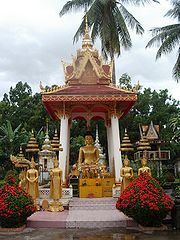 Buddhist shrine in Vientiane
Buddhist shrine in Vientiane
The official and dominant language is Lao, a tonal language of the Tai linguistic group. However only slightly more than half of the population can speak Lao, the remainder speaking various ethnic minority languages, particularly in rural areas. The written language is based on Khmer writing script. Languages like Khmu and Hmong are spoken by minorities, particularly in the midland and highland areas.
French, still common in government and commerce, is studied by many, while English, the language of the Association of Southeast Asian Nations (ASEAN), has become increasingly studied in recent years.[51]
Health
Main article: Health in LaosMale life expectancy at birth was at 63.2 and female life expectancy was at 65.9 in 2007.[52] Healthy life expectancy was at 54 in 2006.[52] In 2006, two fifths of the population were not using an improved water resource.[52] Government expenditure on health is at about 4 % of the GDP.[52] Its amount was at US$ 18 (PPP) in 2006.[52]
Religion
Main article: Religion in LaosOf the people of Laos 67% are Theravada Buddhist, 1.5% are Christian, and 31.5% are other or unspecified according to the 2005 census.[53] Buddhism has long been one of the most important social forces in Laos.
Theravada Buddhism along with the common animism practiced among the mountain tribes, coexists peacefully with spirit worship. Christians are mostly restricted to the Vientiane area, and Muslims to the Burmese-border region. Christian missionary work is regulated by the government.
Education
Main article: Education in LaosThe adult literacy rate exceeds two thirds.[54] The male literacy rate exceeds the female literacy rate.[52] In 2004 the net primary enrollment rate was at 84%.[52] The National University of Laos is the Laos state's public university. The total literacy rate is 73% (2010 estimate).
Culture
Main article: Culture of LaosSee also: Lao art, Lao cuisine, Dance and theatre of Laos, List of festivals in Laos, and Music of Laos An example of Lao cuisine
An example of Lao cuisine
Theravada Buddhism is a dominant influence in Lao culture. It is reflected throughout the country from language to the temple and in art, literature, performing arts, etc. Many elements of Lao culture predate Buddhism, however. For example, Laotian music is dominated by its national instrument, the khaen, a type of bamboo pipe that has prehistoric origins. The khaen traditionally accompanied the singer in lam, the dominant style of folk music. Among the various lam styles, the lam saravane is probably the most popular.
Sticky Rice is a characteristic staple food and has cultural and religious significance to the Lao people. Sticky rice is generally preferred over jasmine rice, and sticky rice cultivation and production is thought to have originated in Laos. There are many traditions and rituals associated with rice production in different environments, and among many ethnic groups. For example, Khammu farmers in Luang Prabang plant the rice variety Khao Kam in small quantities near the hut in memory of dead parents, or at the edge of the rice field to indicate that parents are still alive.[55]
Marriage
Polygamy is officially a crime in Laos, though the penalty is minor. The constitution and Family Code bars the legal recognition of polygamous marriages, stipulating that monogamy is to be the principle key of contracting a marriage in the country. While rare, there have been cases of polygamy practiced within the Hmong people.[56]
Media
All newspapers are published by the government, including two foreign language papers: the English-language daily Vientiane Times and the French-language weekly Le Rénovateur. Additionally, the Khao San Pathet Lao, the country's official news agency, publishes English and French versions of its eponymous paper. Laos currently has nine daily newspapers, 90 magazines, 43 radio stations and 32 TV stations operating throughout the country.[57] Internet cafes are now common in the major urban centres and are popular especially with the younger generation.
See also
- Outline of Laos
- Index of Laos-related articles
- List of freedom indices
- List of Laos-related topics
- North Vietnamese invasion of Laos
- Scouts Lao
Leaders of ethnic minorities in Laos
Notes and references
- ^ a b c "Background notes – Laos". US Dept. of State. http://www.state.gov/r/pa/ei/bgn/2770.htm. Retrieved 20 January 2011.
- ^ a b c d "Laos". International Monetary Fund. http://www.imf.org/external/pubs/ft/weo/2011/01/weodata/weorept.aspx?sy=2008&ey=2011&scsm=1&ssd=1&sort=country&ds=.&br=1&c=544&s=NGDPD%2CNGDPDPC%2CPPPGDP%2CPPPPC%2CLP&grp=0&a=&pr.x=58&pr.y=5. Retrieved 30 April 2011.
- ^ "Human Development Report 2009. Human development index trends: Table G". The United Nations. http://hdr.undp.org/en/media/HDR_2009_EN_Complete.pdf. Retrieved 5 October 2009.
- ^ These same pronunciations using Wikipedia's pronunciation respelling key: lowss, lah-ohss, lay-oss.
- ^ "definition of Laos from Oxford Dictionaries Online". Oxforddictionaries.com. http://oxforddictionaries.com/view/entry/m_en_gb0457240#m_en_gb0457240. Retrieved 24 July 2011.
- ^ "Laos – Definition and More from the Free Merriam-Webster Dictionary". Merriam-webster.com. http://www.merriam-webster.com/dictionary/laos. Retrieved 24 July 2011.
- ^ a b "Laos Securities Exchange to start trading". Ft.com. 10 January 2011. http://www.ft.com/cms/s/0/2d309312-1cb3-11e0-a106-00144feab49a.html#axzz1BP9Somjj. Retrieved 23 January 2011.
- ^ Kislenko, Arne (2009). Culture and customs of Laos. ABC-CLIO. p. 20. ISBN 9780313339776. http://books.google.com/books?id=D6CuONua48MC&pg=PR20. Retrieved 18 July 2011.
- ^ Hayashi, Yukio (2003). Practical Buddhism among the Thai-Lao: religion in the making of a region. Trans Pacific Press. p. 31. ISBN 9784876984541. http://books.google.com/books?id=SZ73WQmu0iEC&pg=PA31. Retrieved 18 July 2011.
- ^ "Fa Ngum". History.com. http://www.history.com/topics/fa-ngum. Retrieved 23 January 2011.
- ^ "Let's hope Laos hangs on to its identity". Asianewsnet.net. http://www.asianewsnet.net/home/news.php?sec=3&id=15718. Retrieved 23 January 2011.
- ^ Librios Semantic Environment (11 August 2006). "Laos: Laos under the French". Culturalprofiles.net. http://www.culturalprofiles.net/Laos/Directories/Laos_Cultural_Profile/-1064.html. Retrieved 23 January 2011.
- ^ Laos – Google Books. Books.google.com.au. 15 January 2005. ISBN 9781741040869. http://books.google.com/?id=A61wRiwTbPgC&pg=PA23&lpg=PA23&dq=Laos+never+important+to+france#v=onepage&q=Laos%20never%20important%20to%20france&f=false. Retrieved 23 January 2011.
- ^ "History of Laos". Lonelyplanet.com. 9 August 1960. http://www.lonelyplanet.com/laos/history. Retrieved 23 January 2011.
- ^ MacKinnon, Ian (3 December 2008). "Forty years on, Laos reaps bitter harvest of the secret war". The Guardian (London). http://www.guardian.co.uk/world/2008/dec/03/laos-cluster-bombs-uxo-deaths. Retrieved 7 May 2010.
- ^ "Laos – Climate". Countrystudies.us. http://countrystudies.us/laos/45.htm. Retrieved 23 January 2011.
- ^ "Laos travel guides". Indochinatrek.com. http://indochinatrek.com/laos/lao-guides.html. Retrieved 23 January 2011.
- ^ "national Statistics Centre". Nsc.gov.la. http://www.nsc.gov.la/Products/Populationcensus2005/PopulationCensus2005_chapter2.htm. Retrieved 23 January 2011.
- ^ "National Statistics Centre". Nsc.gov.la. http://www.nsc.gov.la/Products/Populationcensus2005/PopulationCensus2005_chapter2.htm. Retrieved 23 January 2011.
- ^ Amnesty International (29 April 1998). "Thongsouk Saysangkhi's death". http://www.amnesty.org/en/library/info/ASA26/007/1998/en.
- ^ Unrepresented Nations and Peoples Organization. "WGIP: Side event on the Hmong Lao, at the United Nations". http://www.unpo.org/article/5095. Retrieved 20 April 2011.
- ^ The Times (30 July 2006). "No way out". London. http://www.timesonline.co.uk/tol/life_and_style/article690367.ece.
- ^ "Lao PDR". World Bank. 2011-07-14. http://www.worldbank.org/lao. Retrieved 2011-07-24.
- ^ "Constitution of the Lao PDR" (PDF). http://confinder.richmond.edu/admin/docs/laos.pdf. Retrieved 2011-07-24.
- ^ a b Amnesty International (May 2010). "Submission to the UN Universal Periodic Review: Eighth session of the UPR Working Group of the Human Rights Council". http://www.amnesty.org/en/library/asset/ASA26/003/2009/en/cc4c3494-169c-4d62-b0c2-20f3f9736056/asa260032009en.html.
- ^ The Telegraph (16 April 2011). "Laos, Vietnam troops kill Hmong Christians". http://www.dailytelegraph.com.au/news/breaking-news/laos-vietnam-troops-kill-hmong-christians/story-e6freuyi-1226040033388.
- ^ The straits Times (16 April 2011). "Laos, Vietnam troops kill four Hmong Christians: NGO". http://www.straitstimes.com/BreakingNews/SEAsia/Story/STIStory_657442.html.
- ^ Field Listing – Land use, CIA World Factbook
- ^ About Greater Mekong Subregion at Asian Development Bank
- ^ [1][dead link]
- ^ Genuinely Lao, Rice Today, April–June 2006
- ^ Fifteen years of support for rice research in Lao PDR
Asia brief: Filling the rice basket in Lao PRD partnership results
Genuinely Lao, Prepared by IRRI’s International Programs Management Office - ^ "The Green Revolution comes to Laos". Eurekalert.org. 15 March 2006. http://www.eurekalert.org/pub_releases/2006-03/irri-tgr031506.php. Retrieved 27 June 2010.
- ^ "A Race Against Time" (PDF). http://www.irri.org/publications/annual/pdfs/ar2000/Race.pdf. Retrieved 27 June 2010.[dead link]
- ^ "International Migration, Remittances, and the Brain Drain – ISBN 0821363727" (PDF). http://ces.univ-paris1.fr/membre/Mariani/em/DM_BookWB%5B1%5D.pdf. Retrieved 27 June 2010.[dead link]
- ^ "Preparing the Cumulative Impact Assessment for the Nam Ngum 3 Hydropower Project: Financed by the Japan Special Fund" (PDF). http://www.adb.org/Documents/TARs/LAO/40514-LAO-TAR.pdf. Retrieved 27 June 2010.
- ^ "International visitor data". World Travel & Tourism Council. http://www.wttc.org/eng/Tourism_Research/Economic_Data_Search_Tool/. Retrieved 20 January 2011.
- ^ "Laos – Key Facts". World Travel & Tourism Council. http://www.wttc.org/eng/Tourism_Research/Economic_Research/Country_Reports/Laos/. Retrieved 20 January 2011.
- ^ "The Lao People's Democratic Republic's Vision for Ecotourism". http://www.ecotourismlaos.com/laoecotourism.htm. Retrieved 20 January 20114.
- ^ "Laos Environmental problems & Policy". United Nations Encyclopedia of the Nations. http://www.country-data.com/cgi-bin/query/r-7823.html. Retrieved 20 April 2011.
- ^ "UNDP – Laos Environment & Energy". United Nations Development Programme. http://www.undplao.org/whatwedo/energy_env.php. Retrieved 20 April 2011.
- ^ Buncombe, Andrew (20 April 2011). "Mekong ecology in the balance as Laos quietly begins work on dam". London: The Independent. http://www.independent.co.uk/environment/green-living/mekong-ecology-in-the-balance-as-laos-quietly-begins-work-on-dam-2270082.html. Retrieved 20 April 2011.
- ^ "Vietnam worries about impacts from Laos hydroelectric project". Voices for the Laotian Who do not have Voices. https://khampoua.wordpress.com/tag/laos-hydroelectric-project/. Retrieved 20 April 2011.
- ^ "Mekong dam plans threatening the natural order". The Australian. 29 June 2011. http://www.theaustralian.com.au/news/world/mekong-dam-plans-threatening-the-natural-order/story-e6frg6ux-1226083709322.
- ^ "U.S. furniture demand drives illegal logging in Laos". illegal-logging.info. http://www.illegal-logging.info/item_single.php?it_id=2605&it=news. Retrieved 20 April 2011.
- ^ "Illegal Logging Increasingly Prevalent in Laos". voanews.com. http://www.voanews.com/lao/news/a-52-2009-02-24-voa3-90694899.html. Retrieved 20 April 2011.
- ^ a b c d Simon O'Meally 2010. Unsung progress in rural sanitation: Building the foundations in Lao PDR. London: Overseas Development Institute
- ^ "The Regulation of mall-Scale Water Providers in Lao PDR. Agence Française de Développement". afd.fr. http://www.afd.fr/jahia/Jahia/lang/en/home/publications/travaux-de-recherche/publications-scientifiques/focales. Retrieved 17 February 2011.
- ^ "Khmu people of Laos. OMF International". Omf.org. http://www.omf.org/omf/us/peoples_and_places/people_groups/khmu_of_laos. Retrieved 23 January 2011.
- ^ "Encyclopedia Brittanica: Laos – Ethnic groups and languages". Britannica.com. http://www.britannica.com/EBchecked/topic/330219/Laos/52500/People?anchor=ref509292. Retrieved 23 January 2011.
- ^ "Languages of Laos". Ethnologue.com. http://www.ethnologue.com/show_country.asp?name=LA. Retrieved 23 January 2011.
- ^ a b c d e f g "HDRstats.undp.org". HDRstats.undp.org. http://hdrstats.undp.org/en/countries/data_sheets/cty_ds_LAO.html. Retrieved 27 June 2010.
- ^ "CIA the World Factbook". Cia.gov. https://www.cia.gov/library/publications/the-world-factbook/geos/la.html. Retrieved 23 January 2011.
- ^ "Human Development Report 2009 – Lao People's Democratic Republic". Hdrstats.undp.org. http://hdrstats.undp.org/en/countries/data_sheets/cty_ds_LAO.html. Retrieved 27 June 2010.
- ^ "Evaluation Synthesis of Rice in Lao PDR" (PDF). http://www.adb.org/Evaluation/case-studies/LAO/Evaluation-Synthesis-on-Rice.pdf. Retrieved 27 June 2010.
- ^ "Lao PDR: Family Code". Genderindex.org. http://genderindex.org/country/Lao-PDR. Retrieved 23 January 2011.
- ^ Vientiane Times, 18 February 2011
External links
- Lao PDR News
- The National Portal of Laos
- Lao National Tourism Administration
- Chief of State and Cabinet Members
- BBC News – Country Profile: Laos
- Lao Voices
- Lao Media
- Tageo Laos
- Lao Cooking and The Essence of Life
- General information
- Laos entry at The World Factbook
- Laos from UCB Libraries GovPubs
- Laos at the Open Directory Project
- Wikimedia Atlas of Laos
- Laos travel guide from Wikitravel
Laos topics Politics Constitution · Ruling party · President · Vice President · Prime Minister · Parliament · Elections · Political parties · Military · Emblem · Human rights · Foreign relations · Law · Law enforcement · Government in exileHistory Peopling · Khun Borom · Tai peoples · Lan Xang · Wat Phou · Luang Phrabang · Viang Chan · Champasak · Muang Phuan · French Indochina · Japanese invasion · Lao Issara · Kingdom of Laos · Lao Royal Family · List of kings · Indochina Wars · First Indochina War · Second Indochina War · Ho Chi Minh trail · Pathet Lao · Laotian Civil War · Vietnamese invasion · Neutrality · History until 1945 · History since 1945 · Insurgency · 2007 coup attempt · Military historyGeography Economy Society Culture · Demographics · Lao people · Minorities · Language · Education · Health · Dramatic arts · Music · Sports · Cuisine · Religion · Festivals · Flag · Anthem · RankingsOutline · IndexGeographic locale Countries and other territories in Southeast Asia Sovereign states Dependent territories - Christmas Island, Australia
- Cocos (Keeling) Islands, Australia
Subdivisions - Andaman and Nicobar Islands, India
- Hainan, PRC
- Paracel Islands, PRC
- Pratas Islands, ROC
- Spratly Islands
- (Taiping Island, ROC)
International membership and history Socialism by country History and variants History Brazil · Canada · France · India · Great Britain · Netherlands · New Zealand · Pakistan · United StatesVariants Communist states Africa Asia Afghanistan · Azerbaijan · PR China · Kampuchea (1975–79) · Kampuchea (1979–1993) · Laos · Mongolia · North Korea · North Vietnam · South Vietnam · South Yemen (1967–1990) · South Yemen (1994) · Tuva · VietnamEurope Albania · Bulgaria · Czechoslovakia · East Germany · Finland · Hungary · Poland · Pridnestrovian Republic · Romania · Soviet Union · YugoslaviaLatin America Cuba · GrenadaAssociation of Southeast Asian Nations Governance Member states Enlargement Summits/Forums - ASEAN Summits
- ASEAN +3
- AMU
- ASEAN Regional Forum
- ASEM
- East Asia Summit
- CEPEA
- CMI
Related articles - Anthem
- Common Time
- Date of Establishment
- Emblem
- Flag
- Hymn
- Organizations
- SEA Games
- Secretariat
- Treaty of Amity and Cooperation
East Asia Summit (EAS) - First
- Second
- Third
- Fourth
- Fifth
- Sixth
Member states and observers of the Francophonie Members - Albania
- Andorra
- Armenia
- Belgium
- Benin
- Bulgaria
- Burkina Faso
- Burundi
- Cambodia
- Cameroon
- Canada
- Cape Verde
- Central African Republic
- Chad
- Comoros
- Cyprus1
- Democratic Republic of the Congo
- Republic of the Congo
- Côte d'Ivoire
- Djibouti
- Dominica
- Egypt
- Equatorial Guinea
- France
- Gabon
- Ghana1
- Greece
- Guinea
- Guinea-Bissau
- Haiti
- Laos
- Luxembourg
- Lebanon
- Macedonia2
- Madagascar
- Mali
- Mauritania
- Mauritius
- Moldova
- Monaco
- Morocco
- Niger
- Romania
- Rwanda
- St. Lucia
- São Tomé and Príncipe
- Senegal
- Seychelles
- Switzerland
- Togo
- Tunisia
- Vanuatu
- Vietnam
Observers 1 Associate member.
2 Provisionally referred to by the Francophonie as the "former Yugoslav Republic of Macedonia"; see Macedonia naming dispute.Socialism by country History and variants History Brazil · Canada · France · India · Great Britain · Netherlands · New Zealand · Pakistan · United StatesVariants Communist states Africa Asia Afghanistan · Azerbaijan · PR China · Kampuchea (1975–79) · Kampuchea (1979–1993) · Laos · Mongolia · North Korea · North Vietnam · South Vietnam · South Yemen (1967–1990) · South Yemen (1994) · Tuva · VietnamEurope Albania · Bulgaria · Czechoslovakia · East Germany · Finland · Hungary · Poland · Pridnestrovian Republic · Romania · Soviet Union · YugoslaviaLatin America Cuba · GrenadaFrench overseas empire Former Former French colonies in Africa and the Indian Ocean Maghreb - Algeria
- Morocco (Arguin Island)
- Tunisia
French West Africa French Equatorial Africa Comoros - French Somaliland (Djibouti)
- Madagascar
- Ile de France
- Seychelles
Former French colonies in the Americas Inini · Berbice · Saint-Domingue (Haiti) · Tobago · Virgin Islands · France Antarctique · Equinoctial FranceFormer French colonies in Asia and Oceania French India Indochinese Union French Mandate for Syria and the Lebanon Oceania France-Asia relations · French East India CompanyPresent  Overseas departments and territories of France
Overseas departments and territories of FranceInhabited areas 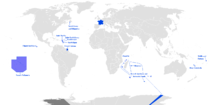 Special status
Special statusUninhabited areas Pacific Ocean French Southern and
Antarctic LandsBanc du Geyser4 · Bassas da India4 · Europa Island4 · Glorioso Islands3, 4, 5 · Juan de Nova Island4 · Tromelin Island4, 51 Also known as overseas regions. 2 Claimed by Comoros. 3 Claimed by Madagascar. 4 Claimed by Seychelles. 5 Claimed by Mauritius.Categories:- Laos
- Communist states
- French-speaking countries
- Landlocked countries
- Least developed countries
- Member states of La Francophonie
- Member states of the Association of Southeast Asian Nations
- Republics
- Single-party states
- Socialist states
- Southeast Asian countries
- States and territories established in 1949
- Member states of the United Nations
- Outline of Laos
Wikimedia Foundation. 2010.

![Location of Laos (green)in ASEAN (dark grey) — [Legend]](/pictures/enwiki/50/250px-Location_Laos_ASEAN.svg.png)
